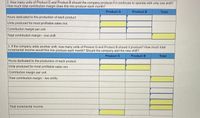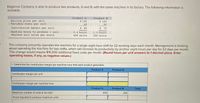
FINANCIAL ACCOUNTING
10th Edition
ISBN: 9781259964947
Author: Libby
Publisher: MCG
expand_more
expand_more
format_list_bulleted
Concept explainers
Question
1,2,3

Transcribed Image Text:2. How many units of Product G and Product B should the company produce if it continues to operate with only one shift?
How much total contribution margin does this mix produce each month?
Product G
Product B
Total
Hours dedicated to the production of each product
Units produced for most profitable sales mix
Contribution margin per unit
Total contribution margin - one shift
3. If the company adds another shift, how many units of Product G and Product B should it produce? How much total
incremental income would this mix produce each month? Should the company add the new shift?
Product G
Product B
Total
Hours dedicated to the production of each product
Units produced for most profitable sales mix
Contribution margin per unit
Total contribution margin - two shifts
Total incremental income

Transcribed Image Text:Edgerron Company is able to produce two products, G and B, with the same machine in its factory. The following information is
available.
Product G
Product B
Selling price per unit
Variable costs per unit
$ 120
$ 160
40
90
Contribution margin per unit
$ 80
$70
Machine hours to produce 1 unit
Maximum unit sales per month
0.4 hours
1.0 hours
600 units
200 units
The company presently operates the machine for a single eight-hour shift for 22 working days each month. Management is thinking
about operating the machine for two shifts, which will increase its productivity by another eight hours per day for 22 days per month.
This change would require $15,000 additional fixed costs per month. (Round hours per unit answers to 1 decimal place. Enter
operating losses, if any, as negative values.)
1. Determine the contribution margin per machine hour that each product generates.
Product G
Product B
Contribution margin per unit
Contribution margin per machine hour
Product G
Product B
Total
Maximum number of units to be sold
600
200
Hours required to produce maximum units
Expert Solution
This question has been solved!
Explore an expertly crafted, step-by-step solution for a thorough understanding of key concepts.
This is a popular solution
Trending nowThis is a popular solution!
Step by stepSolved in 4 steps with 3 images

Knowledge Booster
Learn more about
Need a deep-dive on the concept behind this application? Look no further. Learn more about this topic, accounting and related others by exploring similar questions and additional content below.Similar questions
- A, B, Carrow_forwardHansen Corporation. a C Corporation (mot a manufacturer) reports the following items in income and expenses for 2021 Gross Revenue $900,000 Dividend Received from 30% owned Corp 200,000 LTCG 30,000 STCL 12000 City of Lee's Summit Bond Interest 10000 COGS 375000 Administrative Expenses 325000 Charitable Contribution 60,000 Compute Hansen's C Corp Taxable income?arrow_forwardCalculate: (1+)" m m where m=132, and r=0.102arrow_forward
arrow_back_ios
arrow_forward_ios
Recommended textbooks for you

 AccountingAccountingISBN:9781337272094Author:WARREN, Carl S., Reeve, James M., Duchac, Jonathan E.Publisher:Cengage Learning,
AccountingAccountingISBN:9781337272094Author:WARREN, Carl S., Reeve, James M., Duchac, Jonathan E.Publisher:Cengage Learning, Accounting Information SystemsAccountingISBN:9781337619202Author:Hall, James A.Publisher:Cengage Learning,
Accounting Information SystemsAccountingISBN:9781337619202Author:Hall, James A.Publisher:Cengage Learning, Horngren's Cost Accounting: A Managerial Emphasis...AccountingISBN:9780134475585Author:Srikant M. Datar, Madhav V. RajanPublisher:PEARSON
Horngren's Cost Accounting: A Managerial Emphasis...AccountingISBN:9780134475585Author:Srikant M. Datar, Madhav V. RajanPublisher:PEARSON Intermediate AccountingAccountingISBN:9781259722660Author:J. David Spiceland, Mark W. Nelson, Wayne M ThomasPublisher:McGraw-Hill Education
Intermediate AccountingAccountingISBN:9781259722660Author:J. David Spiceland, Mark W. Nelson, Wayne M ThomasPublisher:McGraw-Hill Education Financial and Managerial AccountingAccountingISBN:9781259726705Author:John J Wild, Ken W. Shaw, Barbara Chiappetta Fundamental Accounting PrinciplesPublisher:McGraw-Hill Education
Financial and Managerial AccountingAccountingISBN:9781259726705Author:John J Wild, Ken W. Shaw, Barbara Chiappetta Fundamental Accounting PrinciplesPublisher:McGraw-Hill Education


Accounting
Accounting
ISBN:9781337272094
Author:WARREN, Carl S., Reeve, James M., Duchac, Jonathan E.
Publisher:Cengage Learning,

Accounting Information Systems
Accounting
ISBN:9781337619202
Author:Hall, James A.
Publisher:Cengage Learning,

Horngren's Cost Accounting: A Managerial Emphasis...
Accounting
ISBN:9780134475585
Author:Srikant M. Datar, Madhav V. Rajan
Publisher:PEARSON

Intermediate Accounting
Accounting
ISBN:9781259722660
Author:J. David Spiceland, Mark W. Nelson, Wayne M Thomas
Publisher:McGraw-Hill Education

Financial and Managerial Accounting
Accounting
ISBN:9781259726705
Author:John J Wild, Ken W. Shaw, Barbara Chiappetta Fundamental Accounting Principles
Publisher:McGraw-Hill Education